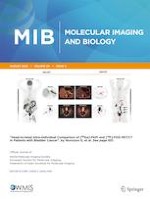Erschienen in:

10.01.2022 | Research Article
Synthesis and Evaluation of Radioiodine-Labeled pH (Low) Insertion Peptide Variant 7-Like Peptide as a Noninvasive Tumor Microenvironment Imaging Agent in a Mouse MDA-MB-231 Triple-Negative Breast Cancer Model
verfasst von:
FengYu Wu, YueHua Chen, DaCheng Li, ZhenGuang Wang, MingMing Yu
Erschienen in:
Molecular Imaging and Biology
|
Ausgabe 4/2022
Einloggen, um Zugang zu erhalten
Abstract
Purpose
The pH (low) insertion peptide (pHLIP) family can target the tumor microenvironment (TME). If pHLIP can be labeled with radioiodine, the imaging and treatment of tumors can be considered. However, tyrosine and tryptophan can bind with iodine in the insertion region of pHLIP, and radioiodine labeling may affect the formation of α-helix structures in acidic environments; therefore, it is necessary to adjust the structure of pHLIP. This study aims to develop an 125I-labeled pH (low) insertion peptide variant 7-like peptide (pHLIP (Var7) LP) for imaging the TME in MDA-MB-231 triple-negative breast cancer (TNBC) xenograft tumor models.
Procedures
Based on pHLIP (Var7), a new peptide sequence, pHLIP (Var7) LP, was obtained by the sequence modification method and then characterized. The binding of pHLIP (Var7) LP to MDA-MB-231 cells was analyzed. pHLIP (Var7) LP was labeled with 125I by the iodogen iodination method. Serial biodistribution studies and small-animal single photon emission computed tomography (SPECT)/computed tomography (CT) imaging in subcutaneous MDA-MB-231 TNBC-bearing mice were performed using [125I] I-pHLIP (Var7) LP.
Results
A novel peptide, pHLIP (Var7) LP, has the characteristics of an α-helix structure, electronegativity, and amphiphilicity. Circular dichroism (CD) spectroscopy showed that the peptide presented a typical pH-dependent transition from an unstructured conformation to an α-helix structure when the pH was reduced from 8.0 to 4.0. The relative fluorescence intensities of 5-carboxytetramethylrhodamine (5-TAMRA)-pHLIP(var7) LP at pH = 6.0, 6.6, and 7.4 were 100.00 ± 5.98%, 72.10 ± 4.65%, and 13.72 ± 1.41%, respectively. The distribution of [125I] I-pHLIP (Var7) LP in tumors reached the highest level (8.7 ± 1.6% ID/g) at 2 h after injection, and the tumor-to-muscle ratios and tumor-to-blood ratios increased with time. Of the measured off-target organs, the stomach, kidney, and bladder showed higher uptake levels. SPECT imaging revealed rapid and sustained tumor uptake of [125I] I-pHLIP (Var7) LP in breast cancer-bearing mice.
Conclusions
This study showed that [125I]I-pHLIP (Var7)LP had rapid and sustained tumor uptake in MDA-MB-231 TNBC and provided a new method for TNBC imaging and further treatment.











